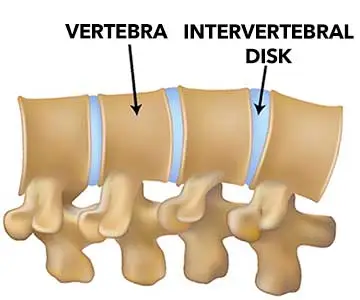Intervertebral disc disease is a serious condition seen more often in dogs than cats. Intervertebral discs are cushioning pads of fibrocartilage that sit between most of the vertebra of the spinal column. The discs have an outer layer of tough fibrous tissue and a center that is more of a gel-like substance. They act as shock absorbers for the bones called vertebra in the spinal column.
Unfortunately, intervertebral discs are subject to degeneration, bulging outward, and even bursting or rupturing. When something goes wrong with a disc, the material inside escapes into the spinal column, pressing against the spinal cord or nerve roots, which causes pain, nerve damage, and sometimes, paralysis. This is the condition known as intervertebral disc disease or IVDD.
Depending on the location of the damaged disc, problems can occur anywhere in the animal’s body from the neck to the rear limbs. In cats, the problem discs are more often found in the neck and upper back. In humans, the condition is sometimes called a slipped disc or a herniated disc.
IVDD is one of the most common neurologic disorders seen in pets, especially dogs. Most aging dogs have some degeneration of intervertebral discs, which commonly results in a condition known as spondylosis. Most of the time, spondylosis doesn’t cause pain or weakness and doesn’t progress to intervertebral disc disease.

Darryl L. Millis, MS, DVM, DACVS, DACVSMR, CCRP
Professor of Orthopedic Surgery & Director of Surgical Service
Robin Downing, DVM, MS, DAAPM, DACVSMR, CVPP, CCRP
Diplomate of the American Academy of Pain Management, is a a founder and past-president of the International Veterinary Academy of Pain Management.
Janet B. Van Dyke, DVM
Diplomate American College of Veterinary Sports Medicine and Rehabilitation, CCRT, CEO
Ludovica Dragone, DVM, CCRP
Vice President of VEPRA, Veterinary European of Physical Therapy and Rehabilitation Association.
Andrea L. Henderson, DVM, CCRT, CCRP
Resident, Canine Sports Medicine and Rehabilitation
Steven M.Fox, MS, DVM, MBA, PhD
President Securos. Inc
When disks between vertebrae in the cervical (neck) or thoracolumbar (chest and back) areas of the spine degenerate, the inner disk material can protrude or rupture into the spinal canal. This, in turn, can cause localized compression of the spinal cord (called myelopathy) and/or of nerve roots (called radiculopathy) at the site of the disk damage. Two primary forms of IVDD occur in domestic dogs; these are called Hansen Type I and Hansen Type II. Both involve degeneration of intervertebral disks, but the mechanisms of degeneration and the predisposed breeds are different.
Hansen Type I IVDD is an acute hernation of the disk that comes on explosively and typically affects chondrodystrophic breeds (those with breed-specific and acceptable hereditary skeletal deformities, such as Dachshunds, Shih-Tzus, Beagles, Pekingese, Poodles, Corgies, Bassett Hounds and dogs with similar characteristics of genetic dwarfism).
Hansen Type II IVDD refers to a more gradual, chronic protrusion of disk material that typically affects nonchondrodystrophic breeds, such as German Shepherds, Labrador Retrievers and Doberman Pinschers. Regardless of the type of IVDD, prompt treatment is necessary to prevent progressive neurological damage.
Hansen type-III IVDD disc disease is also known as ‘acute non compressive’ or ‘high-velocity low volume’ disc disease. In this case there is a sudden onset of disease typically with heavy exercise or trauma, causing a normal nucleus to explode from a sudden tear in the annulus – the injury to the spinal cord does not result in on-going spinal cord compression and with rehabilitation and physiotherapy patients tend to recover without surgical interventionThe consequence of disc herniation is pain and in more severe cases there may be difficulty walking – ranging from poor control of the hindlimbs, a ‘drunken sailor’ walk to complete paralysis. Very severe cases may develop myelomalacia (softening and dying of the spinal cord) and as it ascends the spinal cord is usually fatal since it affects the nerves involved in breathing resulting in respiratory arrest.


Owners often notice similar signs after their dog has engaged in strenuous physical activity or experienced acute physical trauma. An acutely ruptured disk can be caused in an otherwise normal dog by jumping off high places, jumping out of a car or off the bed of a pick-up truck, playing a rousing game of fetch or Frisbee or leaping out of an owner’s arms, among other activities. A healthy dog can also suffer acute-onset of disk damage when it has been hit by a car, attacked by another animal or experienced some other form of trauma. This type of acute traumatic injury is not the same as IVDD, although the symptoms can be very similar. IVDD involves a degenerative process and does not result merely from sudden trauma, although sudden trauma can cause rupture or herniation of an intervertebral disk in a dog whose disks already are weakened by IVDD.
Made up of a gelatinous substance surrounded by a thick outer layer, intervertebral discs are basically the shock absorbers of the spine. There are two types of disc herniation seen in dogs: Type I and Type II, of which Type II generally has less severe signs and symptoms.
Symptoms of IVDD may include:
The first part of almost any diagnostic protocol is a thorough history and a complete physical examination. When spinal injuries are suspected, a complete neurological examination is warranted. In cases of IVDD, the neurological examination will be consistent with a single, focal lesion in the spinal cord and will help the veterinarian localize the site of injury to a particular section of the spine. However, a neurological examination will not confirm whether intervertebral disk disease is the cause of the dog’s injury.
Regular blood work (a complete blood count and a serum biochemistry panel) and a urinalysis are not particularly useful if the sole problem is IVDD; the results of these “initial database tests” will be normal in an otherwise healthy dog. Sampling and assessing the cerebrospinal fluid (CSF) by way of a spinal tap can provide more helpful information, as can an electromylogram (EMG). Typically, cerebrospinal fluid (CSF) analysis is most useful to rule out causes other than IVDD, such as cancer, infection or inflammation from another source. Radiographs (x-rays) of the spine are almost always recommended and typically are performed under anesthesia or heavy sedation. Radiographs can reveal abnormalities in the vertebrae and the spaces between them that can help rule out IVDD, such as bone tumors, fractures, discospondylitis or other potential causes of spinal cord damage. Radiographs can also reveal narrowed intervertebral disk spaces that are consistent with, but not diagnostic of, IVDD.
Another form of medical imaging that is indicated for most dogs suspected of having spinal cord damage is called myelography. This involves injecting a contrast medium directly into the spinal canal, waiting a specific period of time to allow that material to move through the cerebrospinal fluid within that canal, and then taking survey radiographs to look for any pressure points from bulging disk material. Disc herniation and spinal cord compression will usually show up with the contrast between the injected dye and the radiographic outline of the vertebral bones. Other advanced imaging procedures that can be highly useful to diagnose IVDD include computed tomography (CT/CAT scan) and magnetic resonance imaging (MRI). Myelography, CT scan and MRI are all advanced diagnostic procedures that are not routinely available at most general veterinary practices. They are, however, available at specialty veterinary clinics and at veterinary teaching hospitals affiliated with veterinary schools.
There are many dogs diagnosed with intervertebral disc disease that do not require surgery. These dogs can be effectively managed with rehabilitation. Early intervention and support is vital as is a thorough assessment and implementation of a staged rehabilitation treatment plan.
In the initial stage following diagnosis of IVDD the aims of rehabilitation will be to:
These above aims continue and progress with time depending on your dogs progress. Aims will ultimately develop to include the following:
Many different rehabilitation therapeutic modalities can be employed when rehabilitating a dog undergoing conservative management of IVDD. Possible options might include – laser, or and cold therapy, massage, range of motion exercises and stretches, muscle stimulation, hydrotherapy, home exercise program and advice to prevent further injury.
The following table is an example of a rehabilitation programme our practitioners may use with your dog:
| Timeline | Physiotherapy Aims | Rehabilitation Therapy options |
|---|---|---|
| Week 0 to 4 | Reduce inflammation |
|
| Reduce muscular guarding |
| |
| Improve core stability |
| |
| Increase strength |
| |
| Increase sensation and awareness of body position |
| |
| Maintain soft tissue length and flexibility |
| |
| Management at home |
| |
| Week 4 to 6 | Continue as above |
|
| ||
| ||
| Week 6 to 12 | Increase exercise tolerance |
|
| Continue to increase core stability |
| |
| Week 12 onwards | Return to full function |
|